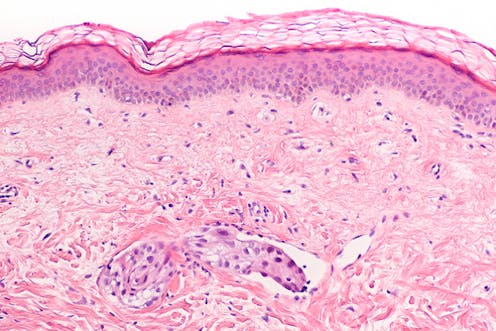Beyond October: Things to be aware of all year about breast cancer
Breast cancer awareness month may be over, but don't put away your pink. The disease is with us year-round. While researchers have found several ways to treat it, here are some things to know.

Almost all of us have a friend or relative who has battled breast cancer, and that is in large part because the disease is so common. One in eight women has a lifetime risk of being diagnosed with the disease. Breast cancer causes about 15 percent of cancer-related deaths in the United States, making it the second-largest cancer killer of women in the U.S., second to lung cancer.
And so, we walk, we run and we donate in October. But beyond the nearly ubiquitous pink that surrounds us in October, there is a lot more going on microscopically with this disease. When we speak of breast cancer, we are actually talking about dozens of different diseases. Many of these have in common only that they originated in the breast, when in fact, on a cellular level, some might have more in common with a cancer in another part of the body, such as ovarian cancer.
Even though breast cancer awareness month is now over, we believe as cellular biologists who study breast cancer that it is important for people to be aware of the disease year-round. About 250,000 women – and 2,500 men – were estimated to be diagnosed with the disease in 2017.
Some women’s fights will be tougher than others. Many thousands will go on to never face the disease again.
More than one disease, more than one treatment
Breast cancer is an umbrella term for different types of malignant tumors that arise in the breast. Each tumor may have its own distinct tissue structure, genetics and prognosis. Therefore, researchers aren’t looking for a “silver bullet” that will cure all breast cancers.
Rather, researchers search for ways to identify the specific type of tumor a patient has and to tailor treatments to that diagnosis. To do so, a better understanding of the complexity of breast cancer based on genetic makeup of a particular person’s disease is required. Tumors from different patients differ from each other in pathological features and molecular signature. This is called intertumor heterogeneity.
Broadly, breast cancer is divided in two categories based on how the tumor looks under the microscope. This includes the tissue type and the involvement of surrounding cells. Based on whether the cancer is found, breast cancer is classified initially either as ductal carcinoma in situ, commonly called DCIS among doctors and patients who have been diagnosed with this form, or invasive breast cancer, which means the cancer has spread from the ducts to breast tissue itself.
DCIS is a pre-malignant and pre-invasive form of breast cancer that is confined in the milk ducts or is found in the lining of milk ducts. DCIS has significant potential of progressing into invasive breast cancer. At this time, however, doctors and researchers do not yet have a way to tell which DCIS cancers might progress into invasive cancers and those that will not.

To treat DCIS, doctors typically use lumpectomies, in which the tumor itself and a small amount of tissue surrounding it are surgically removed; or mastectomies, in which the entire breast is surgically removed, to treat the DCIS tumors.
But, a single tumor can have features of the ductal type and invasive type.
Molecular differences abound
Researchers have discovered that breast cancer has at least four different molecular subtypes. As a result, pathologists today will perform a biopsy of breast cancer cells soon after a woman is diagnosed. The cancer then is classified into four subtypes by whether certain kinds of receptors that fuel growth are present on the surface of the breast cancer cells.
Growth of certain breast tumors is fueled by estrogen. These are called estrogen receptor-positive (or ER-positive) breast cancers.
Others are fueled by the hormone progesterone. These are called progesterone receptor-positive (or PR-positive).
Some can be both ER/PR-positive, and are also known as luminal tumors.
Others can be negative for both estrogen and progesterone but positive for a hormone called human epidermal growth factor receptor 2 (HER2). These are called HER2-positive breast cancers.
Highly effective targeted treatments are now available for breast cancers that test positive for either ER/PR and HER2. This has tremendously improved their disease outcomes.
When testing negative is bad
Among all the molecular subtypes, a disease called triple negative breast cancer is one of the most aggressive subtypes of breast cancer.
They are set apart because they have none of the three receptors that doctors test for in breast tumors – hence the term, “triple negative.” That’s also what makes them hard to treat – because they have no receptors, they have no molecules for the conventional treatments to target.
These cancers are more aggressive, more likely to spread to other parts of the body and more likely to be fatal. They are also two to three times more common in women of African descent than in women of European descent.
Tumors can be complicated
We and many others are working to come up with better treatments for triple negative breast cancer and to improve outcomes for those with other breast cancer subtypes. We are learning different parts of the tumor of an individual patient can be different in terms of their inherent characteristics, behavior and response to treatments. This is where things become complicated.
In fact, even a single breast tumor can contain multiple kinds of cancer cells, and the balance of cells can shift with time and treatment. Different parts of the tumor of an individual patient can be different in terms of their inherent characteristics and behavior. This is called intra-tumor heterogeneity and is a hot research area. Doctors typically make treatment decisions based on the biopsies that sample one region of the tumor.
If different parts of the tumors harbor cancer cell populations with different traits, there is a chance that some of those cells may be able to resist treatments, expand in numbers and eventually repopulate the tumor - leading to disease recurrence and spread.
Also, a given tumor can change or evolve over the time of its growth within the patients, or due to treatment, or the cancer cells of the tumor change as the disease spreads to new locations in the patient’s body. Therefore, the more heterogeneous a tumor is, the greater the likelihood of a poor outcome for a patient.
Moving forward
There are many promising avenues of research related to breast cancer – more than 100 clinical trials are happening right now that attempt to develop more specific targeted treatments.
Other researchers are looking into treatments that will attack different kinds of tumor cells at the same time. Still others are teasing out methods that use the body’s own immune system to create targeted treatments.

All of these avenues point to the future of research into breast cancer and into cancer more generally. That future does not lie in a single breakthrough, for the simple reason that one size doesn’t fit all.
Instead, we are working toward precision medicine, where treatment for each patient is customized to her body and her specific diagnosis. And every discovery we make moves us closer to the day when breast cancer is a death sentence for no one.
Padmashree Rida is affiliated with Novazoi Theranostics, Inc.
Ritu Aneja receives funding from the National Institutes of Health.
Karuna Mittal does not work for, consult, own shares in or receive funding from any company or organisation that would benefit from this article, and has disclosed no relevant affiliations beyond their academic appointment.
Read These Next
As DOJ begins to release Epstein files, his many victims deserve more attention than the powerful me
Powerful men connected to Jeffrey Epstein are named, dissected and speculated about. The survivors,…
How to reduce gift-giving stress with your kids – a child psychologist’s tips for making magic and a
Depending on family circumstances and a child’s personality type, gift giving runs the gamut of fun…
The world risks forgetting one of humanity’s greatest triumphs as polio nears global eradication − 7
Polio may finally be defeated in the next 5 years. Will the world recognize what an extraordinary achievement…






